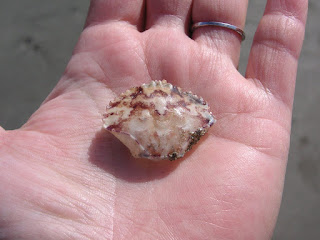When I first started Nature ID back in May 2009, Andy I were visiting San Luis Obispo County a little more frequently than we do now, and my blog subtitle was "from the Central Coast of California." Thanks to school and changes in our lifestyle, we stay closer to home in Monterey County these days, so I've re-subtitled Nature ID to reflect the change of location focus.
However, it's only been 3 weeks since I last visited this beach on October 12, 2011 in Morro Bay, about 150 miles southeast of Monterey Bay. The weather couldn't have been more different with a high of 67.5°F compared to the 92.8°F previously.
My friend Jennifer, who is also a regular commenter on Nature ID, loved my sand dollar shots. Since she had never really been to Morro Bay, I thought it'd be a good idea to play hookey from our responsibilities and do a girls' trip. And, yes, she found many, many sand dollars, not to mention added new bird sightings to her brother's Birdpost [no longer available] site.
Heavy sigh... Morro Strand State Beach is on the list for closure in the coming year along with 69 other CA State Parks. Unlike back in 2009 when Mr. Terminator proposed closing 80% of CA's 278 State Parks, this year's threat of closure feels realistic and more serious. While I can see them closing and fencing off the campground, I just can't imagine any agency being able to keep people off this awesome 3-mile beach. With no restrooms, no refuse containers, or other maintenance and management, I predict the quality of this beach will quickly go downhill. Public-private partnerships have been organized to attempt to fill the gaps throughout the state, but it takes a cadre of folks willing to volunteer their money, time, sweat, and expertise. Randy at Way Points has been vocal with his posts about Trail Closure at Garrapata and Henry Coe gets a Reprieve. I'm surprised other CA nature bloggers I follow haven't said much on this very important and relevant topic. Save Our State Parks seems to me to be the best organization out there spreading the word.
ps 05/31/12 - The Central Coast Natural History Association Executive Director contacted me and asked if they could use my last picture of the SOS sign alongside the standard brown State Parks sign on the cover of their "Nature Notes" newsletter. They're a non-profit that raises money for their local SLO County State Parks and have been fighting to keep these special parks open for over 4 years. Of course, they have my permission! I sent to her a few higher resolution image files from which to choose.
However, it's only been 3 weeks since I last visited this beach on October 12, 2011 in Morro Bay, about 150 miles southeast of Monterey Bay. The weather couldn't have been more different with a high of 67.5°F compared to the 92.8°F previously.
My friend Jennifer, who is also a regular commenter on Nature ID, loved my sand dollar shots. Since she had never really been to Morro Bay, I thought it'd be a good idea to play hookey from our responsibilities and do a girls' trip. And, yes, she found many, many sand dollars, not to mention added new bird sightings to her brother's Birdpost [no longer available] site.
Heavy sigh... Morro Strand State Beach is on the list for closure in the coming year along with 69 other CA State Parks. Unlike back in 2009 when Mr. Terminator proposed closing 80% of CA's 278 State Parks, this year's threat of closure feels realistic and more serious. While I can see them closing and fencing off the campground, I just can't imagine any agency being able to keep people off this awesome 3-mile beach. With no restrooms, no refuse containers, or other maintenance and management, I predict the quality of this beach will quickly go downhill. Public-private partnerships have been organized to attempt to fill the gaps throughout the state, but it takes a cadre of folks willing to volunteer their money, time, sweat, and expertise. Randy at Way Points has been vocal with his posts about Trail Closure at Garrapata and Henry Coe gets a Reprieve. I'm surprised other CA nature bloggers I follow haven't said much on this very important and relevant topic. Save Our State Parks seems to me to be the best organization out there spreading the word.
ps 05/31/12 - The Central Coast Natural History Association Executive Director contacted me and asked if they could use my last picture of the SOS sign alongside the standard brown State Parks sign on the cover of their "Nature Notes" newsletter. They're a non-profit that raises money for their local SLO County State Parks and have been fighting to keep these special parks open for over 4 years. Of course, they have my permission! I sent to her a few higher resolution image files from which to choose.
























